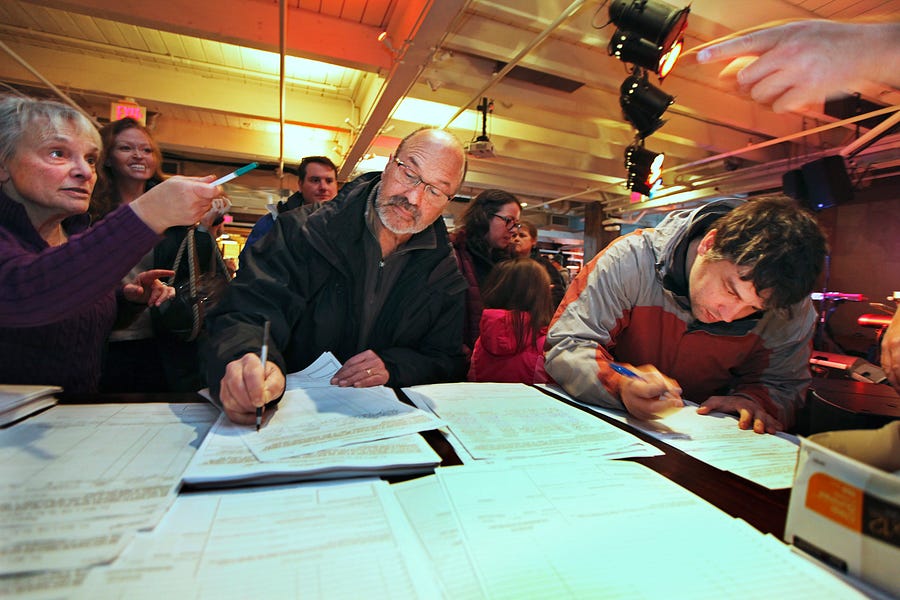When going to the polls this fall—or voting from home—Maine voters will receive a form that looks more like a Microsoft Excel spreadsheet than a typical ballot with a list of names and instructions to check just one box. After a nearly four-year legal battle, Maine will be the first state to use ranked-choice voting in a presidential election. Election-reform advocates will be watching to see whether a voting method that has been employed by a handful of cities and, in the case of primaries, some state parties, can improve our electoral process.
Voters will see a grid that lists the names of all the candidates in one column, next to a blank column in which they will rank those candidates numerically. The exact form of ranked-choice ballots varies from place to place, but the concept is based on the idea that voters shouldn’t have only one vote. Instead, each voter has as many votes as there are candidates in the race. Rather than choose one candidate, voters rank the candidates in order of preference.
If one candidate does not win a majority of first-choice votes, the election proceeds to an “instant runoff,” a misleading term since the runoff process can take days or sometimes longer than a week. What it means is that voters don’t return to the polls for an actual vote. Instead, all but the top two candidates are eliminated from the race and the second-choice votes of people who voted for the eliminated candidates are then redistributed. For example, if a given voter’s first choice was Candidate A (who finishes third in the first round of voting) and their second choice was Candidate B (who finished first), the voter’s second choice vote is assigned to Candidate B as part of their total tally. The process continues until one candidate amasses a majority of votes.
Advocates for ranked choice contend that this method introduces beneficial incentives into the structure of campaigns. “Ranked-choice voting in our state gets the candidate with the broadest and deepest support elected,” says Stan Lockhart, former chairman of the Utah Republican party. The format, Lockhart and others contend, pushes candidates toward appealing to a wider swath of voters.
The change hinges on the fact that under ranked choice, candidates have to win a majority of votes, not just a plurality. Simply galvanizing partisan turnout is a less viable path to victory. Instead, advocates say, candidates must ensure that they get enough second-choice votes to push them over the 50 percent line. Ideally, this encourages campaigning that is less partisan and more focused on issues, because polarizing candidates have a harder time amassing second-choice votes.
Rob Richie, the founder of FairVote, an election reform group that advocates for ranked-choice voting and other changes to elections, says that “when you meaningfully can indicate a second or third choice, rather than just one, you have more reasons to engage with candidates and candidates have more reason to engage with you.”
Not only does ranked choice incentivize politicians to appeal to a broader slice of the electorate, its proponents claim that results will more accurately represent voter preferences. Libertarians who reluctantly vote for Republicans or progressives who begrudgingly back the moderate Democrat now no longer need to make politically meaningless protest votes. Instead, they could indicate their true preferences while preserving using a second-choice vote for a more electorally viable candidate.
Ranked choice, however, has its problems. The system, simply by its novelty and by the relatively complex procedure of getting to a majority—essentially squeezing multiple rounds of voting into one—raises the objection that it makes voting too complicated.
John Whitehurst, a political consultant who works in San Francisco politics, where ranked-choice voting has been used since 2002, says that ranked choice is a “confusing system for people that are new to voting” and presents challenges to voters who have not registered to vote before, are younger, or for whom English is a second language.
Whitehurst also noted that ranked-choice voting’s vaunted appeal to a broader electorate can often have adverse consequences. Ranked-choice voting “dulls the issues,” he said, because candidates “don’t try to show contrasts but show likenesses. … It makes candidates seem similar.” San Francisco politics are also not notably short on negative campaigning, with fierce intra-Democrat battles between moderate and progressive factions, and standoffs between the mayor and the powerful Board of Supervisors.
But ranked choice continues to be adopted by a growing number of towns, cities, and state parties. San Francisco, Oakland, Minneapolis, Portland, and Santa Fe all use ranked choice for a variety of positions, and New York will use it for primary and special elections starting in 2021. In Utah, it’s been possible since 2018 for local governments to opt in to ranked choice, and Virginia passed a bill allowing the same this year.
The only state that has implemented ranked-choice voting, however, is Maine. After Republican Gov. Paul LePage won two elections with less than 50 percent of the vote, the state instituted ranked-choice voting in a statewide referendum.
Ranked choice had a complicated legal journey, however. After the referendum passed, Maine’s Supreme Court issued an advisory opinion that said ranked-choice voting would be unconstitutional for certain statewide elections.The state Senate promptly passed a law that would have delayed implementation unless and until a constitutional amendment was passed.
In response, ranked-choice advocates gathered enough signatures for a “people’s veto,” which blocked the state Senate law until it could be voted on as a ballot question. Voters rejected the law in the 2018 elections, and the veto also exempted constitutionally dubious elections for governor and state legislature from ranked choice, sidelining legal controversies.
But in yet another signature-gathering campaign, the Maine Republican Party attempted to block the law’s implementation at the last minute. The secretary of state, Matthew Dunlap, originally ruled that the effort fell short, but an appeal to a state judge restored enough disqualified signatures to push them over the finish line. Then, in another reversal, the state Supreme Court’s final decision on the case rejected enough signatures to push the state GOP back into defeat.
So after a four-year legal odyssey, Maine is preparing to become the first state to use ranked-choice voting in a presidential election. Overall, the polling in the state has leaned solidly toward Joe Biden, although Maine’s electoral votes are awarded partly by proportionality: two of its four votes go to the overall winner, while the other two are split between the winners of the state’s two congressional districts.
This wrinkle is why the state GOP is making such a last-ditch push to stall ranked choice. Maine’s 1st District, in the more conservative north of the state, has Biden and Trump locked in a dead heat. If second-choice votes from third partiers lean Biden, as they could plausibly be expected to given Trump’s low favorables, the GOP would lose its only chance at any electoral success in Maine.
It’s extremely unlikely, albeit not impossible, that a single electoral vote will swing this election. But the fate of Maine’s 1st District could serve as a useful testing ground for ranked choice’s advocates. If Biden wins on the strength of second-choice votes, their central thesis will be vindicated: the less divisive, less polarizing candidate will be rewarded for appealing to a broader swath of the electorate. And in the case of national elections, where campaigns are often at their most negative and partisan, that might be a small glimmer of hope for the future.
Photograph by Jill Brady/Portland Portland Press Herald/Getty Images.







Please note that we at The Dispatch hold ourselves, our work, and our commenters to a higher standard than other places on the internet. We welcome comments that foster genuine debate or discussion—including comments critical of us or our work—but responses that include ad hominem attacks on fellow Dispatch members or are intended to stoke fear and anger may be moderated.
With your membership, you only have the ability to comment on The Morning Dispatch articles. Consider upgrading to join the conversation everywhere.